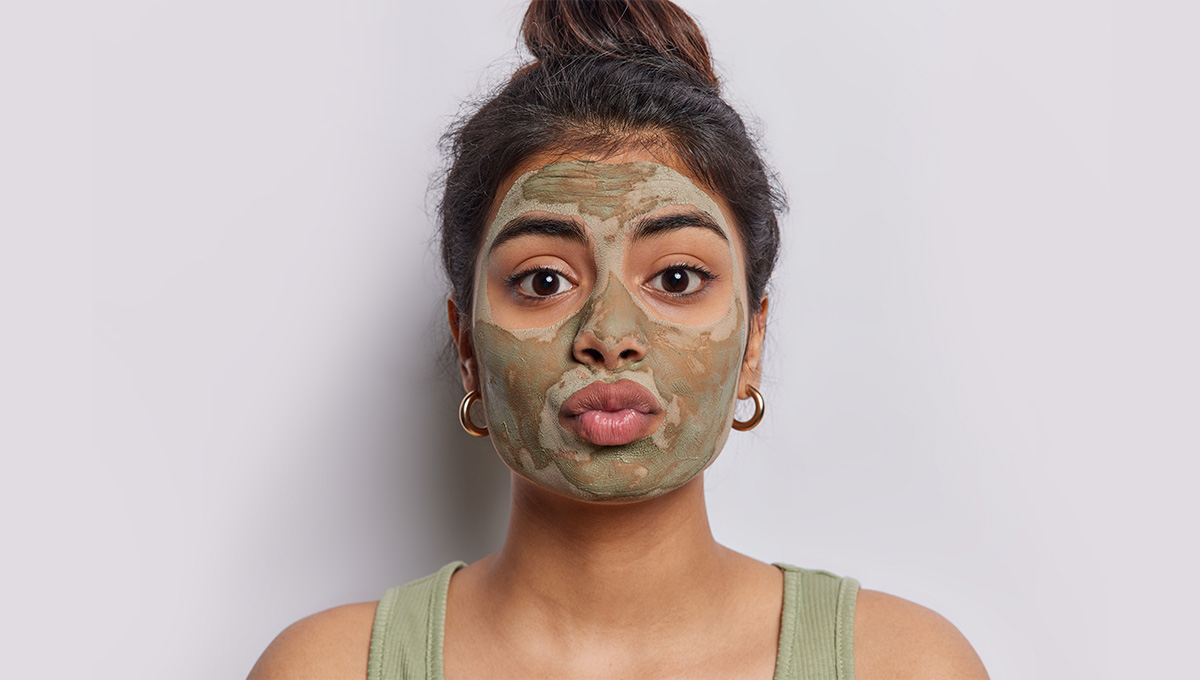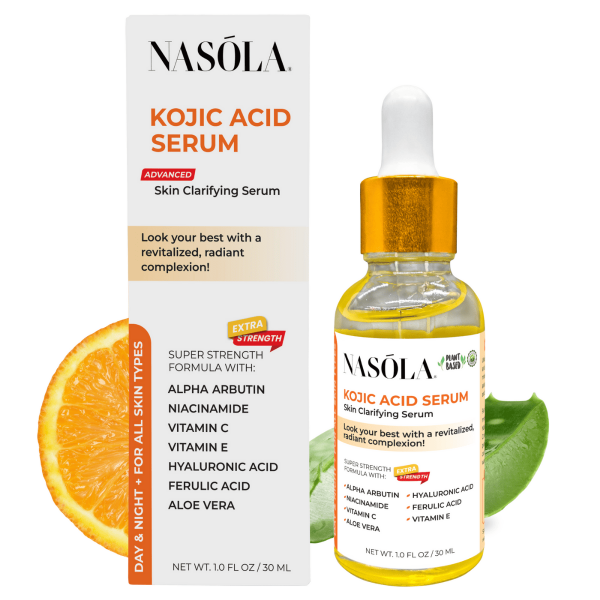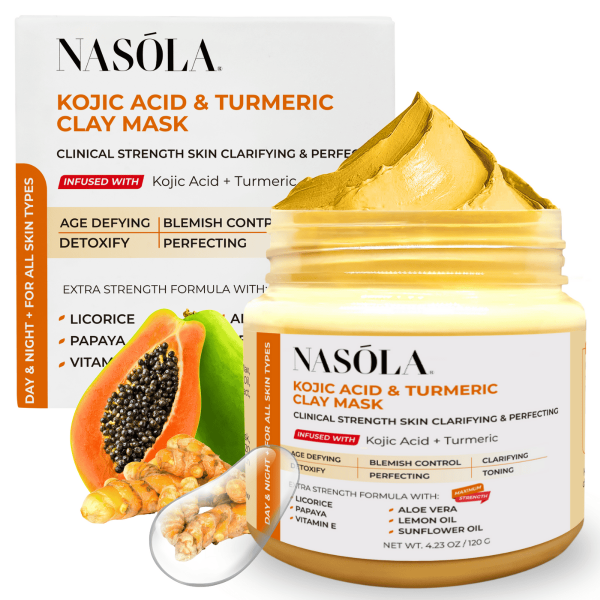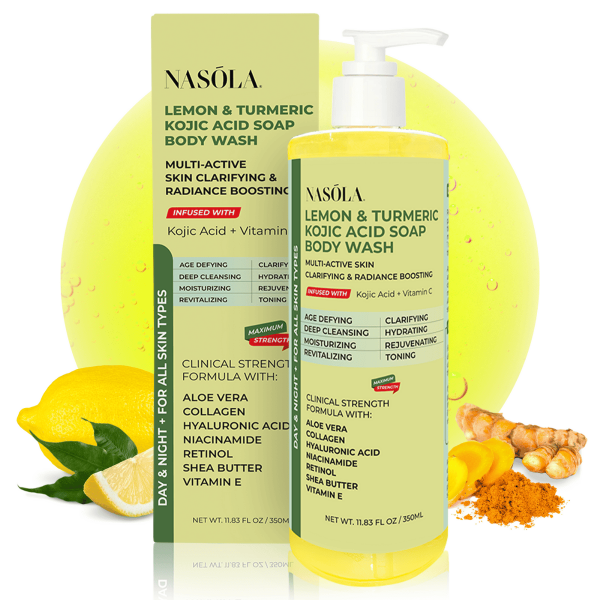There’s something almost poetic about the way the skin feels after a cooling aloe vera face mask.
If you’ve been searching high and low for that dewy, glassy-skin glow, you’re not alone — and yes, aloe might just be the answer.
The aloe vera face mask isn’t new, but the way we’re combining it with ingredients like turmeric, clay, kojic acid, and more? That’s where the real glow-up happens.
In this post, I’ll walk you through the what, the how, and the why of aloe face masks.
Whether you’re DIY-ing at home with just two ingredients or leveling up with professionally formulated blends like the Kojic Acid & Turmeric Clay Mask from Nasola, your skin’s about to receive the royal treatment.
Let’s keep this simple, effective—and above all, soothing.
- What Is an Aloe Vera Face Mask and Why It's Essential for Your Skincare Routine
- Benefits of Using an Aloe Face Mask for All Skin Types
- How to Make Aloe Vera Face Mask at Home
- How to Make Aloe Vera and Turmeric Face Mask for Bright, Even Skin
- Unlock Brighter Skin Daily With Kojic Acid-Infused Aloe Products
- Where Aloe Vera Face Masks Fit in Your Skincare Routine
- Targeting Hyperpigmentation with Aloe Vera and Kojic Acid
- Conclusion
- Frequently Asked Questions (FAQs)
What Is an Aloe Vera Face Mask and Why It’s Essential for Your Skincare Routine
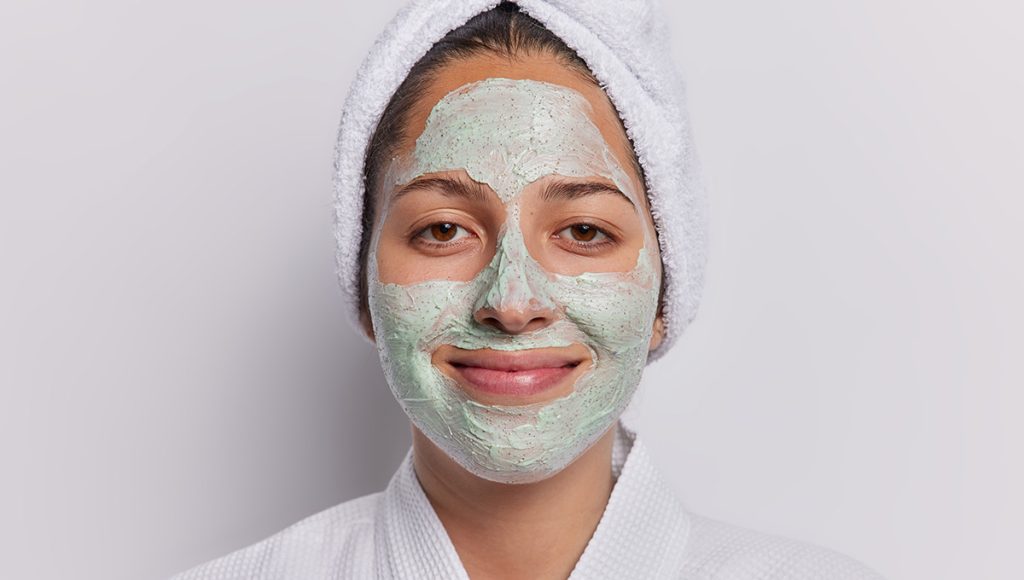
An aloe vera face mask is like a spa day in a jar (or a leaf!). With its rich blend of vitamins A, C, and E, aloe fights off free radicals, heals breakouts, and hydrates thirsty skin—without turning your face into a grease pit. Sounds good? It gets better.
Incorporating an aloe vera face mask into your weekly routine can transform inflamed, reactive skin into a calm, glowy masterpiece.
Especially if you’re fighting acne, dry flakes, or redness that shows up uninvited at the worst times (why always before events, though?).
Let’s explore two of its standout strengths:
Healing Benefits for Acne and Redness
If your skin could scream, it probably would—after a week of hot weather, stress, and poor sleep. That’s where aloe vera steps in with its gentle, soothing superpowers. Loaded with salicylic acid and polysaccharides, it helps:
- Calm inflammation caused by acne or rosacea
- Speed up skin healing without peeling your face off
- Minimize pimple size and redness overnight
- Prevent future breakouts by keeping pores clear
Aloe doesn’t just cool—it actively treats. That’s why it’s a must-have for anyone dealing with flare-ups.
Hydration Without Greasiness
Let’s just say it: hydration shouldn’t feel like smearing Crisco on your cheeks. Aloe vera hydrates in a clean, light way that even oily and combination skin types appreciate.
When applied as a face mask, aloe pulls moisture deep into the layers of your epidermis, all while:
- Regulating oil production without over-drying
- Giving a matte (not flat!) finish
- Leaving no residue or sticky feeling
- Softening fine lines caused by dehydration
It’s skincare that respects your skin—not attacks it.
Benefits of Using an Aloe Face Mask for All Skin Types

Let’s zoom in on the versatility of an aloe face mask. This magical plant doesn’t discriminate—it loves your skin whether it’s dry, flaky, oily, sensitive, or a delightful combo of all the above (we’ve all been there).
Using an aloe face mask balances skin’s pH, evens tone, and strengthens your skin barrier. And when combined with powerhouse ingredients like turmeric and kojic acid? That’s when you start skipping foundation altogether.
For Sensitive Skin
If your skin flips out at the mention of “acid,” relax—aloe plays nice. It cools and comforts, reducing redness and irritation without stingy side effects. You’ll feel it the moment you apply it.
- Reduces sensitivity after sun exposure or over-exfoliation
- Supports healing after breakouts
- Helps prevent barrier damage with regular use
- Layers well with serums or moisturizers for added calm
Add the Nasola Kojic Acid & Turmeric Clay Mask to your routine if you want all the calming benefits of aloe, plus the glow-up from turmeric and kojic acid. It brightens as it soothes, keeping sensitive skin balanced.
For Oily Skin
Greasy t-zone? Aloe’s got this. Its antibacterial properties help manage blemishes while unclogging pores.
Pairing aloe with an oil-absorbing clay mask boosts your glow-up without triggering breakouts.
- Reduces excess oil without dehydrating dry patches
- Prevents pore congestion by sweeping away leftover grime
- Balances sebum production for a shine-free finish
- Encourages a more refined, smooth skin texture
And if you’re dealing with dark spots leftover from breakouts? That’s where kojic acid in the clay mask starts to work its magic.
How to Make Aloe Vera Face Mask at Home
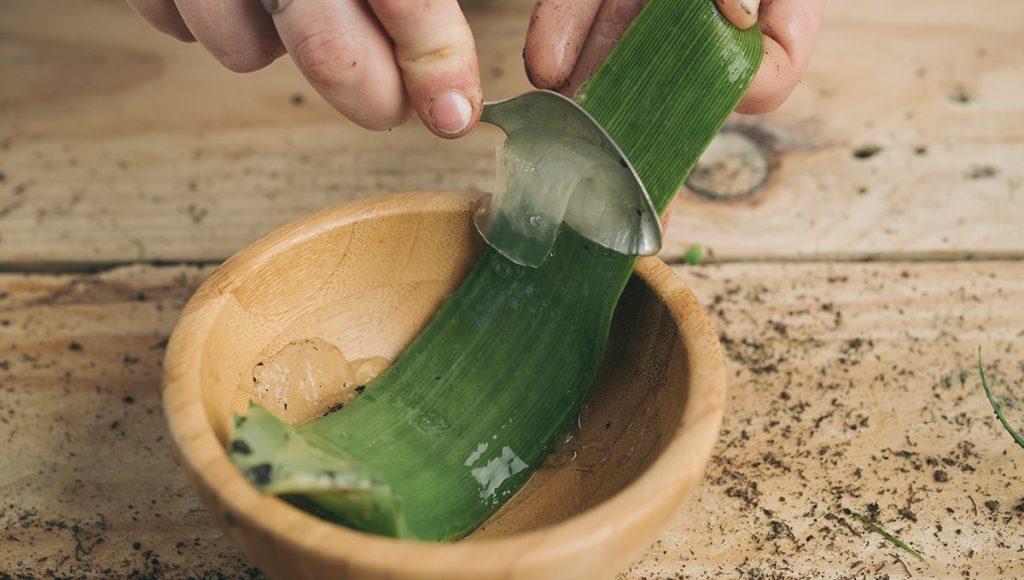
Few things are more satisfying than whipping up your own skincare in the kitchen. If you’ve been wondering how to make aloe vera face mask yourself, you’re in luck—it can be crazy easy and actually fun.
Whether it’s a self-care Sunday or pre-video-call skin revival, these homemade recipes have your back. And if DIY isn’t your thing? Don’t worry—I’ve got a luxury shortcut, too.
Simple 2-Ingredient Recipe: Aloe Vera + Honey
This mask is your golden ticket to smooth, juicy skin. It’s sweet (literally) and crazy effective.
- 2 tablespoons of fresh aloe vera gel (scrape it from the leaf or use 100% gel)
- 1 tablespoon of raw honey
Mix and slather on clean skin. Leave for 15–20 minutes, rinse, and smile at your reflection.
- Hydrates without clogging pores
- Offers antibacterial protection (hello, honey)
- Boosts glow on even the dullest days
- Ideal for dry, flaky skin
Deep Cleansing Variant: Aloe Vera + Bentonite Clay
Ready for a detox session that won’t strip your skin? This combo brings out the big guns without going full-on harsh.
- 1 tablespoon aloe vera gel
- 1 tablespoon bentonite clay
- Few drops of water to adjust consistency
Apply and let it sit until it’s almost dry. Rinse gently.
- Draws out impurities from deep in pores
- Leaves behind a bright, refreshed canvas
- Soothes skin during the detox (thanks, aloe!)
- Tackles oily zones gracefully
Prefer a set-it-and-forget-it solution? The Kojic Acid Cream delivers hydration and brightening with zero mess. A simple, effective alternative.
How to Make Aloe Vera and Turmeric Face Mask for Bright, Even Skin
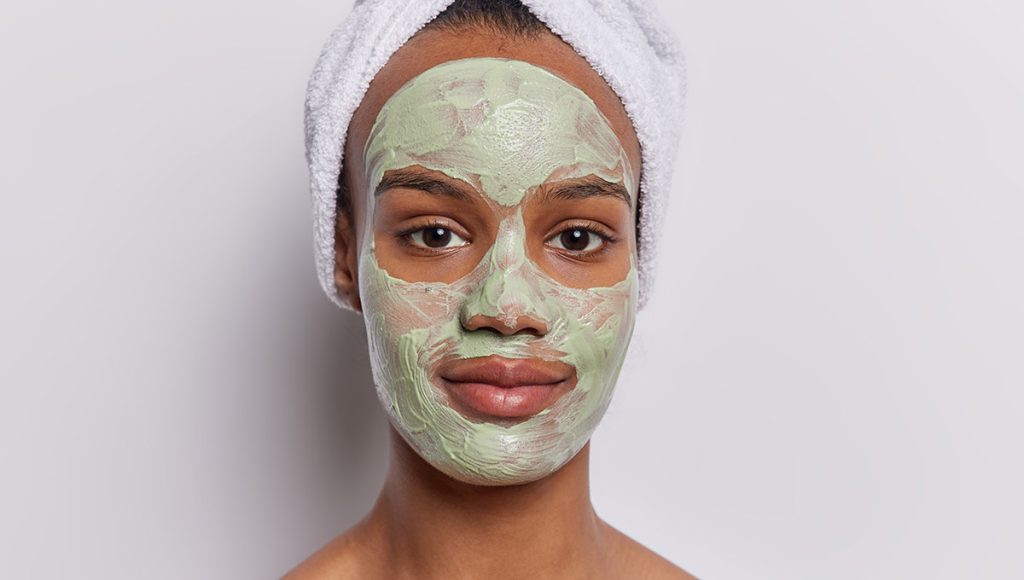
Feeling a little blotchy? Uneven? Dull like a rainy Tuesday? Time to bring in the big glow energy. Learning how to make aloe vera and turmeric face mask—and doing it right—can transform your skin’s tone and texture, naturally.
Turmeric fights inflammation and brightens, while aloe hydrates and calms. Together? They’re the dream team.
Even-Toned Skin Naturally
This combo attacks dark spots, acne scars, and dullness like no other. It fades uneven patches gradually—without burning or peeling.
DIY recipe:
- 1 tablespoon aloe vera gel
- ½ teaspoon turmeric powder (go easy—it stains!)
Apply thinly for 10–15 minutes, ensuring a towel or old shirt is nearby.
- Visibly brightens with regular use
- Calm inflammation at the root
- Promotes cell turnover gently
- Combines healing and hydration in one step
Safe Use Tips
Turmeric is powerful—but oh boy, the stains. You don’t want glowing skin with yellow undertones unless that’s the goal. Playing it safe helps:
- Always do a patch test (especially if you’re new to turmeric)
- Use sparingly; a little goes a long way
- Rinse thoroughly with warm water and a gentle cleanser
- Don’t leave on longer than 20 minutes
Don’t want to play skin scientist with turmeric?
Let the Nasola Kojic Acid & Turmeric Clay Mask do its job—it’s professionally balanced and aloe-infused, meaning no guesswork needed.
Unlock Brighter Skin Daily With Kojic Acid-Infused Aloe Products
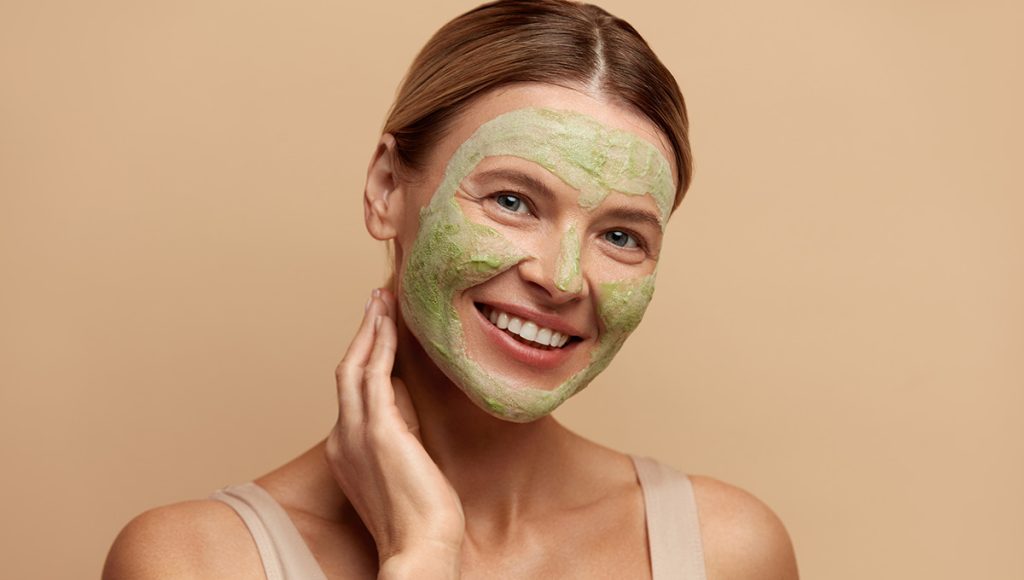
No time for mixing? No blender-cleaning afterwards? I feel you. That’s why kojic acid + aloe-infused products from Nasola are total game-changers. They make it easy to get glowing skin without any effort.
Kojic acid helps fade dark spots and acne scars, while aloe vera cools the skin from any potential irritation. You get glow and calm in one go.
Kojic Acid Cream & Serum
These are your skin’s ride-or-die faves. Use them consistently and watch the transformation.
- Lightens hyperpigmentation gently but effectively
- Reduces post-acne scarring and blotchiness
- Brightens the overall complexion for an even tone
- Aloe keeps skin calm—even with actives involved
Find both the Nasola Kojic Acid Serum and Nasola Kojic Acid Cream —they’re full of natural ingredients that love your skin.
Daily Brightening With Natural Ingredients
Want full-body radiance? Don’t ignore the rest of your skin! This is where the Nasola Lemon Turmeric Kojic Soap Body Wash works magic.
- Exfoliates with natural turmeric and citrus extracts
- Keeps body breakouts and dark patches at bay
- Aloe soothes while turmeric and lemon work hard
- Perfect for knees, elbows, and body acne spots
Add it to your routine after masking for a glow-up from head to toe.
Where Aloe Vera Face Masks Fit in Your Skincare Routine
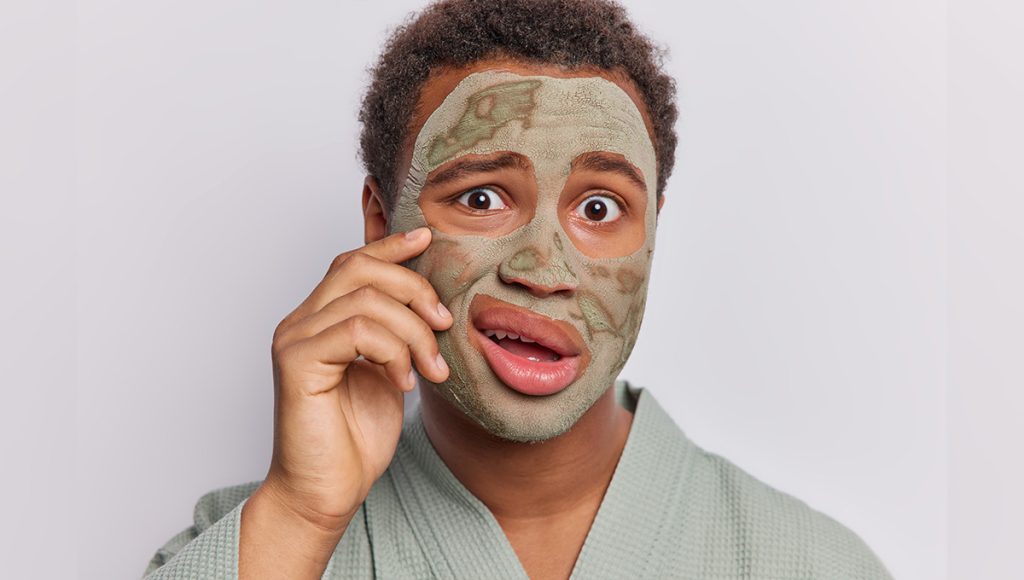
Knowing when and how often to use your aloe mask makes all the difference. Just like you don’t eat cake before dinner every day (well, unless it’s a bad week), there’s a rhythm to skincare, too.
Aloe vera face masks should enhance your routine, not replace it. Treat them like skin therapy—targeted, intentional, and so worth it.
Weekly Detox, Daily Glow
Aloe masks work best used two to three times a week. For sensitive skin? Once a week goes a long way.
- Helps maintain a balanced moisture barrier
- Keeps inflammation in check with regular use
- Restores radiance without over-exfoliating
- Pairs well with calming or locking serums after masking
What to Pair It With
Post-mask is when your skin is most open to soaking up goodness. This is the ideal time to go in with Nasola Kojic Acid Serum.
- It delivers brightening power where it’s needed
- Protects against future discoloration
- Aloe base soothes after active treatments
- Locks hydration into freshly cleaned pores
Apply serum right after you rinse off the mask and pat dry. Follow with a moisturizer or the Nasola Kojic Acid Cream for the full effect.
Targeting Hyperpigmentation with Aloe Vera and Kojic Acid
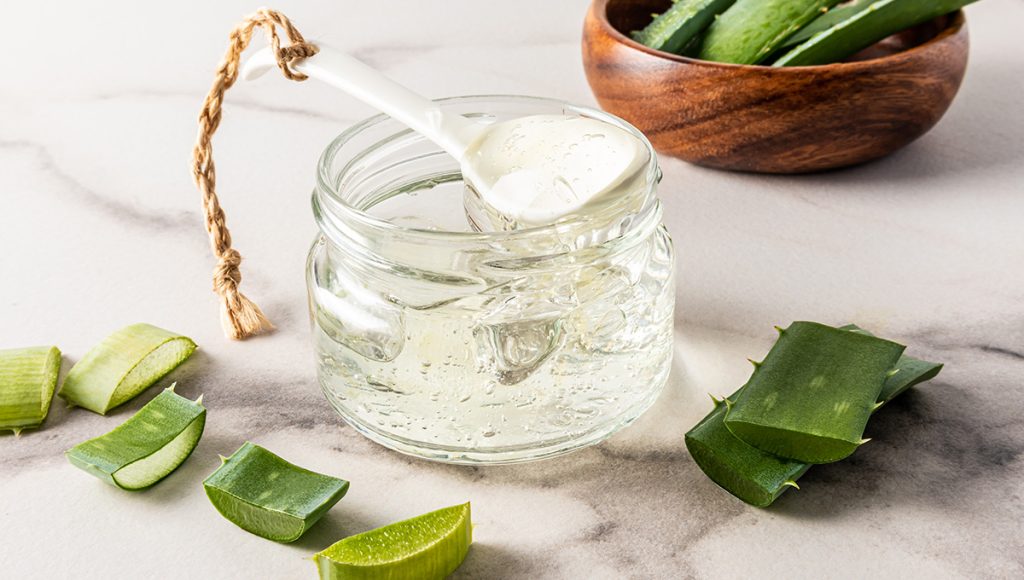
Let’s talk about the dark spots we don’t love. Hyperpigmentation, acne scars, and uneven patches from sun exposure are stubborn but beatable with the right combo: aloe + kojic acid.
When used together, they calm, fade, and defend—without setting your face on fire.
Why Kojic Acid Complements Aloe Masks
These two ingredients balance each other out in the best way.
- Kojic acid targets melanin to lighten dark marks
- Aloe vera calms any irritation that might pop up
- They reinforce healing and regeneration together
- And both are safe for most skin types with proper use
Best Combinations
Try layering products for impact without overwhelm:
- Start with Nasola Kojic Acid & Turmeric Clay Mask 2–3 times weekly
- Use Nasola Kojic Acid Serum right after masking
- Lock in moisture daily with Nasola Kojic Acid Cream
This strategy targets hyperpigmentation while keeping your skin plumped up and protected.
Conclusion
By now you’ve probably realized—an aloe vera face mask isn’t just a trend. It’s a rockstar product your skin didn’t know it needed, especially when paired with natural brighteners like turmeric and kojic acid.
Whether you go all-natural in your kitchen or choose lab-perfected formulations like those from Nasola, aloe’s gentle touch has the power to heal, hydrate, and glow-up any skin type. And when soothing aloe meets pigmentation-fighting kojic acid? Whew… now that’s skincare that works.
So… mask up, moisturize, and let your skin thank you in the mirror.
Frequently Asked Questions (FAQs)
2 to 3 times a week is ideal for most skin types. If your skin is sensitive, try starting with once a week to see how your skin reacts before increasing frequency.
Turmeric is potent and can cause dryness or staining, so limit it to 2 times a week. Aloe can be used more regularly, but always patch test new combos first.
Combine 2 tablespoons of aloe vera gel with a drop or two of tea tree oil or turmeric. For a ready-made solution, try the Nasola Kojic Acid & Turmeric Clay Mask.
An aloe face mask hydrates, soothes inflammation, supports wound healing, fights acne, and relieves dry or sunburned skin. It’s suitable for nearly all skin types.
If it’s pure aloe gel without turmeric or active acids, yes—it’s safe and hydrating overnight. If mixed with ingredients like clay or turmeric, rinse off within 20 minutes.
Raw aloe is more concentrated and fresh but can be irritating to sensitive skin. Store-bought aloe gels are often stabilized and better for allergens. Always patch test!
We recommend starting with the Nasola Kojic Acid Cream or Nasola Kojic Acid Serum. Both are effective at treating discoloration and uneven skin tone.
Absolutely! Aloe enhances the soothing effects post-treatment. Just don’t layer too many actives at once—space them out to avoid irritation.
It can leave a yellowish tint temporarily. Using just a pinch and removing it thoroughly with warm water often prevents staining. Don’t wear your favorite white shirt while masking!
Yes, but start with a patch test. The aloe content helps reduce chances of irritation, though it’s always best to test your skin’s reaction first.

